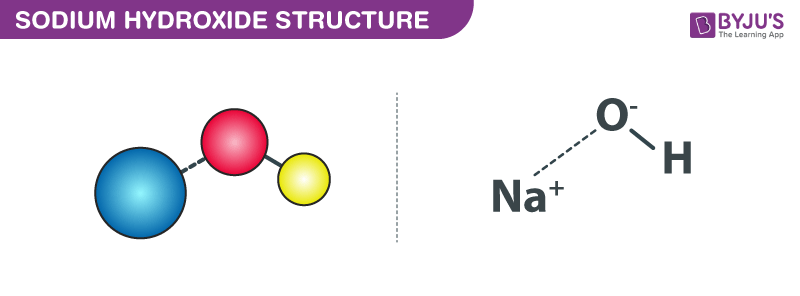What is Sodium Hydroxide?
Sodium Hydroxide is a solid ionic compound. It is also known as caustic soda, Iye, sodium hydrate or soda lye.
It is a co-product of chlorine production. In its pure form, it is crystalline solid, colourless in nature. This compound is highly water-soluble and consists of sodium cations and hydroxide anions. NaOH absorbs moisture from the air. It is highly corrosive and can cause severe skin burn and irritation to eyes and other body parts.
It generates a high level of heat and so is always created by mixing the compound into the water, not the vice versa. In cosmetics, this inorganic compound is used as a buffering agent. It can also control the PH levels. The PH of sodium hydroxide is 13.
Table of Content
- Structure of Sodium Hydroxide
- Properties of sodium hydroxide
- Recommended Videos on Sodium hydroxide
- Preparation of sodium hydroxide
- Uses of sodium hydroxide
- Health Hazards of sodium hydroxide
- FAQs
Sodium Hydroxide Structure – NaOH

Sodium Hydroxide Structure – NaOH
Properties of Sodium Hydroxide – NaOH
Sodium Hydroxide is a white, translucent crystalline solid. It is commonly referred to as caustic soda due to its corrosive action on many substances it decomposes proteins at room temperatures and may cause chemical burn to human bodies. Although it does not occur in nature, sodium hydroxide has been manufactured on large scale for many years from readily obtainable raw material and is used in numerous industrial processes.
| NaOH | Sodium Hydroxide |
| Molecular Weight/ Molar Mass | 39.997 g/mol |
| Density | 2.13 g/cm³ |
| Boiling Point | 1,388 °C |
| Melting Point | 318 °C |
Recommended Videos
Uses of Acids and Bases

Preparation of Sodium Hydroxide

Preparation of Sodium Hydroxide – NaOH
On commercial scale, Caustic soda (sodium hydroxide) can be prepared by an aqueous solution of sodium carbonate (Na2CO3) is treated with hot milk of lime i.e Ca(OH)2 in a tank made up of iron.
Na2CO3 + Ca(OH)2 → CaCO3 + 2NaOH
(ppt.)
The precipitate of Calcium carbonate (CaCO3 ) is removed by filtration and the solution is used for paper making, soap and detergents.
Uses of Sodium Hydroxide- NaOH
- It is used in the manufacturing of detergents and soaps
- It is used in the production of bleach-like chlorine
- It is used in drain cleaners
- It is used in the removal of heavy metals from the water by the municipal water treatment facility
- It is used in food preservatives to prevent bacteria and mould growth
- It is used for canning
- It is used in papermaking and paper recycling process.
Health Hazards of Sodium Hydroxide
- Contact with extremely high concentrations of sodium hydroxide can result in severe burns to the eyes, skin, digestive system, or lungs, which can lead to permanent damage or death.
- Mucous membranes in the nose, throat, lungs, and bronchial system may be damaged. Even tiny doses can cause significant harm.
- Burns the skin and damages the eyes. The respiratory tract is irritated. Irritation of the mucous membranes in the nose.
Avoid coming into touch with your eyes, skin, or clothes. Gases, fumes, dust, mist, vapour, and aerosols should not be inhaled. Wear safety glasses, gloves, and clothes. See Section 8 for further information. Acids should not be mixed. Do not eat, drink, smoke, or use personal products when handling chemical substances.
Frequently Asked Questions-FAQs
What is the sodium hydroxide solution used for?
Sodium hydroxide is used in the manufacture of soaps and a range of detergents used in homes and business applications. Combining chlorine and sodium hydroxide, chlorine bleach is made.
Is sodium hydroxide good for your skin?
Concentrated sodium hydroxide, when swallowed, is a strong irritant and corrosive to the skin, hair, breathing tract and digestive system. Sodium hydroxide has been combined with other components to create an effective, safe and versatile cleaning agent known as soap.
What is the importance of sodium hydroxide?
A metallic caustic base is sodium hydroxide (Na OH), also known as lye or caustic soda. An alkali, caustic soda is commonly used in many industries, mostly in the manufacture of pulp and paper, textiles, drinking water, and detergents as a strong chemical base.
Is sodium hydroxide soluble in ethanol?
Pure sodium hydroxide is a colourless crystalline solid which melts without decomposition at 318 ° C (604 ° F) and boils at 1,388 ° C (2,530 ° F). Despite lower solubility in polar solvents such as ethanol and methanol, it is highly soluble in water.
Why sodium hydroxide is used in soap?
It is not used for shaving, it is used for soap production. Oil and fat triglycerides react with sodium hydroxide to form fatty acid glycerol and sodium salts, the latter being the soaps. The extraction of excess sodium hydroxide is done with great caution because it is very caustic.
Also, Read:
| Bleaching Powder and Sodium Hydroxide | Uses of Sodium Hydroxide |
| Sodium | Preparation, Properties And Uses Of Sodium Chloride |
Learn more about the Structure and properties of NaOH from the experts at BYJU’S.


Comments